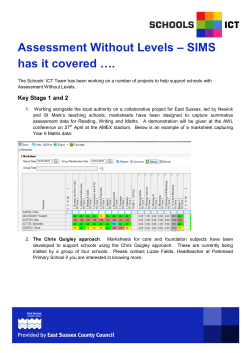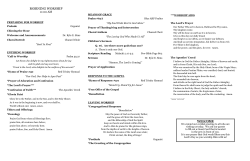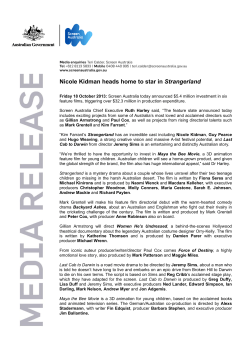
Josef Amann_SIMS Presentation for QI course Cape Town
Site Improvement through Monitoring Systems (SIMS) Josef Amann Interagency SIMS Core Group Member Introduction to Quality Improvement Course Cape Town, South Africa November 2014 Delivering a Sustainable AIDS-free Generation with Accountability, Transparency, and Impact Site Improvement through Monitoring System (SIMS) Site Improvement through Monitoring System (SIMS) 2 Site Improvement through Monitoring System (SIMS) Goals and Objectives Goal The goal of SIMS is to increase the impact of PEPFAR programs on the HIV epidemic through standardized monitoring of quality, at the site, community, and above-site level, focusing on key program area elements Primary Objectives 1. Monitor capacity at sites, community and above-site to provide high-quality HIV/AIDS services in all program areas 2. Facilitate use of these data and quality outcomes to improve services 3. Provide foundational data for regional, national, and global programmatic decision making Secondary Objectives 1. Demonstrate PEPFAR and its implementing agencies’ accountability for funded activities 2. Emphasize in-country technical staff role in accountability, monitoring, and improvement 3. Improve capacity building by: • Providing guidance to assess the content of services through standards-based monitoring • Recognizing successes to improve morale and accountability of staff 3 SIMS TIMELINE June –July 31st • Developing modular toolkit for “sites” where PEPFAR services are delivered (facility and community) • Orientation meeting for 20 countries June-September • Developing above-site and TA modules for all program areas and budget codes September 30th • First quarter of data collected • Minimum 1 site visit per mechanism January 2015 • All OUs collecting on all modules October 2014 • Meeting for remaining OUs March 2015 • Opportunity to revise all CEEs 4 Where in the world is SIMS? Oriented to SIMS Facility and Community tools at Johannesburg Workshop; implementing SIMS; will be oriented to Supportive Functions/Above-Site tool virtually Will be oriented to all SIMS tools at Bangkok Workshop in October What is a SIMS Site Visit? • A rapid assessment of services provided at a facility or community or service-delivery point of care or program intervention • The assessment uses a tool of core essential elements (quality standards) to assess all PEPFAR-funded program areas of a facility, community and above-site • The SIMS assessment consists of: – Discussions with key facility and implementing partner staff – A facility walk-through, and chart review (if applicable) • Conducted by USG staff (different from quarterly Implementing Partner visits required in the MER) 6 Defining a ‘Site’ • Sites are defined within the PEPFAR Monitoring, Evaluation and Reporting (MER) indicator reference sheet PEPFAR Site Support (SITE_SUPP) • Site definitions are consistent among SIMS, MER, and integrated PEPFARsupported Site List (iPSL) • Facility Site: SIMS adopts the existing definitions for facilities from the MER • Community Site – The lowest geographic administrative unit – Could be a “ward” or “sub-district” – Population-level data should be available – Multiple domains/types of interventions can take place in a site • Above-site/supportive function site assessment point 7 SIMS has 3 modular toolkits 1. Facility 2. Community 3. Above-Site/Supporting Functions All modules are finalized and should be adapted, translated and implemented in-country 8 Above-Site/Supporting Functions standards Facility standards Community standards Improved quality of PEPFAR-supported services Sustained HIV Epidemic Control AFTER THE SIMS ASSESSMENT IS CONDUCTED – WHAT’S NEXT? OR HOW ARE WE MAKING SURE THINGS CHANGE – IMPROVEMENT HAPPENS 10 Actors/Players • Health Care Facility, Community-based Staff – Run or operate the health care facility, CBO, intervention point, etc. – provide the HIV services • Implementing Partner – supports the health care facility staff or community site/intervention point (technical assistance, training mentoring, salary support, commodities etc) – has to be physically present at the site at least once per quarter (MER requirement) • USG in-country staff – Oversight of the implementing partners activities – Monthly meeting with the implementing partner – Conducts the SIMS assessment • MOH, Provincial or District Health Management Teams – Supervision/mentoring functions Guiding Principles • SIMS is conducted to ensure high quality HIV services and programs and to improve the quality • SIMS is a major part of oversight of the implementing partner by the USG in-country staff • SIMS Data is the most useful in-country and should be used primarily in-country by USG staff when monitoring/working with the implementing partner • Implementing partner is main facilitator of improvement Quality Assurance vs. Quality Improvement 13 Quality Assurance vs. Quality Improvement SIMS 14 Quality Assurance vs. Quality Improvement SIMS 15 Improvement – at different times in different forms • Site feedback and debrief • Quality improvement project at the site • Implementing partner monitoring and oversight by the USG staff • Program-level review and improvement 16 IMPROVEMENT: SITE FEEDBACK AND DEBRIEF 17 Site Feedback – Improvement starts here • Sites or Intervention Points should receive sameday feedback in the form of a Facility or Community Dashboard and a Debrief • Site involvement and feedback critical components to SIMS • Promotes staff ownership and accountability for services they are providing and for improving them • Non-punitive approach • Provide accompanying tool as explanation 18 SIMS Dashboard SIMS Dashboard • Left at Site • No Site composite score indexed or CEEs differently weighted 19 Debrief -- Improvement • • • All actors/players are there Some issues can be address or fixed right there, no need of a root cause analysis or a formal QI project Some issues just have to be brought to the attention of the health care facility staff or intervention point staff IMPROVEMENT: QUALITY IMPROVEMENT PROJECTS AT SITE 21 Quality Improvement Projects at a site • Issues or gaps identified through the SIMS assessment may become the topic of a Quality Improvement (QI)Project at the health facility site Example: Liwale District Hospital scored RED for Cotrimoxazole during the SIMS assessment 2.1 Cotrimoxazole All patients should have documented prescription of cotrimoxazole (CTX), according to national guidelines. Q1 Question Pull 10 charts. What percent of charts reviewed have documentation of CTX prescription within an appropriate interval per the national guidelines at the last clinical assessment? SCORE Response Y N Scoring If <60%=Red If 60-79%=Yellow If 80-89%=Light Green if ≥90%=Dark Green Quality Improvement Projects at a site QI Team Liwale District Hospital Quality Improvement Projects at a site QI Team Liwale District Hospital • Will identify Cotrimoxazole as topic for a QI project Quality Improvement Projects at a site QI Team Liwale District Hospital • Will conduct a root cause analysis Quality Improvement Projects at a site QI Team Liwale District Hospital Quality Improvement Projects at a site • QI projects are supervised by the implementing partner – Documentation of results/improvement – Report to USG staff in monthly partner meeting – Dissemination of best practices identified in one site to all other sites they support IMPROVEMENT: IMPLEMENTING PARTNER MONITORING AND OVERSIGHT BY USG STAFF 28 Implementing Partner Monitoring System/Process in USG-Country offices • Formal SIMS reports to the implementing partners • Meetings (e.g. monthly) of the Activity Manager/Project officer with the Implementing Partner • Meetings (e.g. quarterly) with all Implementing Partners around specific topics/issues Implementing Partner Monitoring System/Process in USG-Country offices • Formal SIMS reports to the implementing partners and the MOH Implementing Partner Monitoring System/Process in USG-Country offices • Formal SIMS reports to the implementing partners with Action Plan All Sites of one IP in one Region 32 IMPROVEMENT: PEPFAR COUNTRY PROGRAM OVERALL 33 Look at the PEPFAR Program Overall • Look at the HIV program overall (across all partners) – Improvement could mean re-focus of program activities/resources Overall SMS Score Card of one CDC-country program Thank You!
© Copyright 2025












